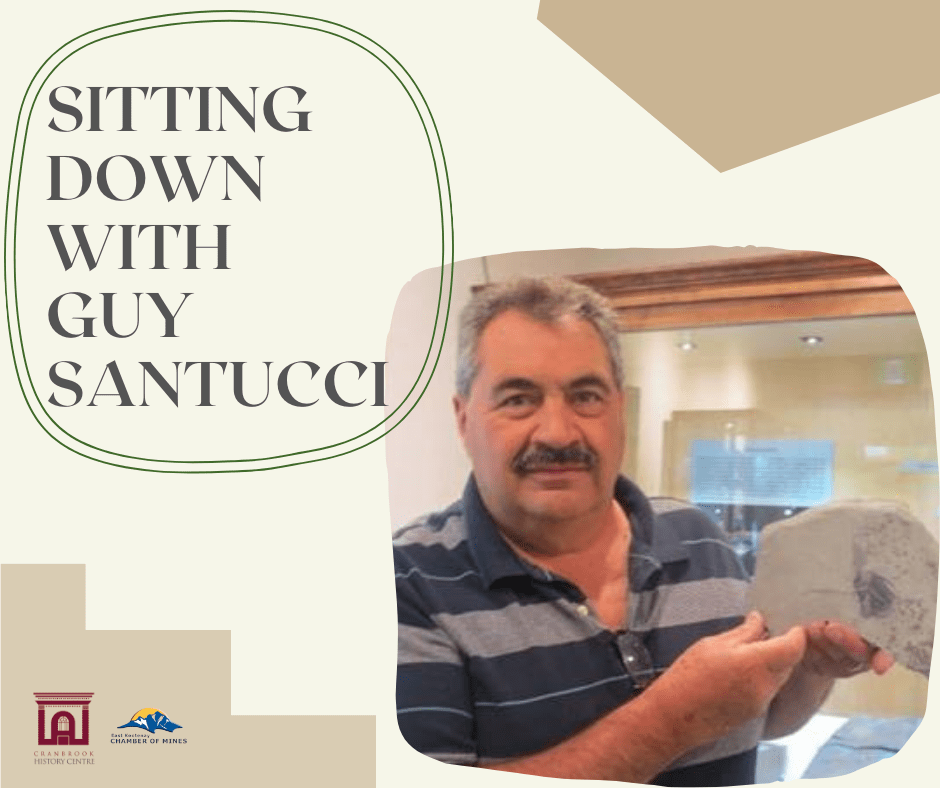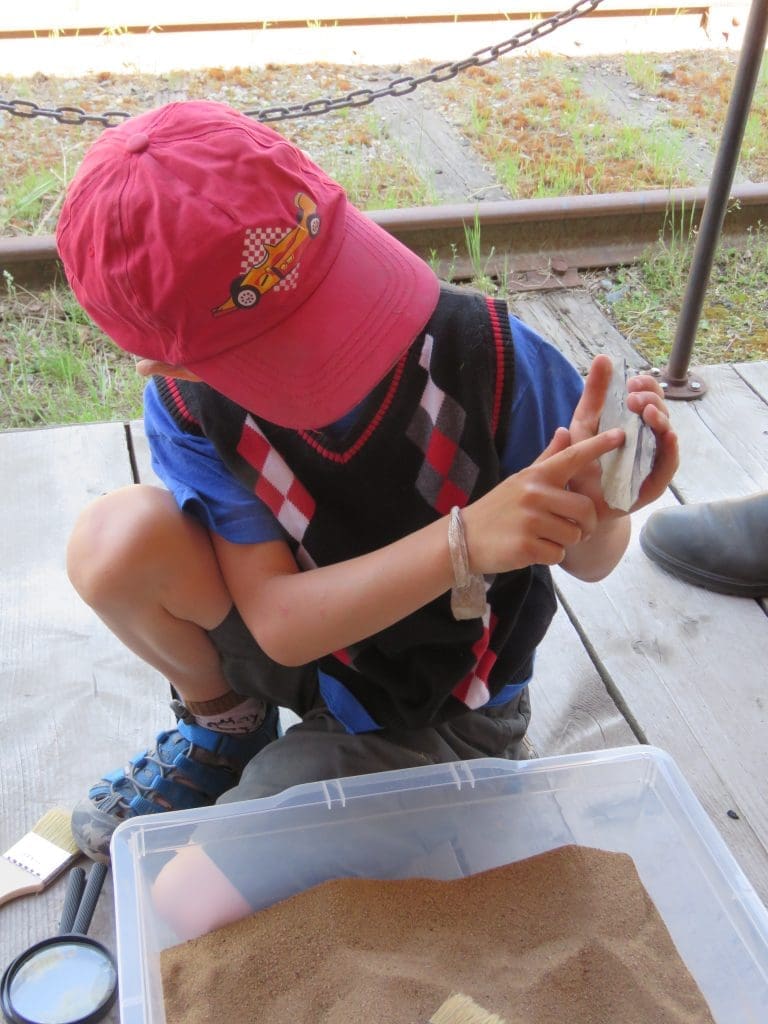
Sitting Down With Guy Santucci
By Emily Russell

Guy Santucci is a local paleontologist here in Cranbrook. He is also one of the co-founders of the Cranbrook History Centre’s Junior Paleontology program, which has been running for upwards of five years now. Not only did Guy help start our program, but he also provides the fossils used in our popular rock-breaking activity and our new Junior Paleontology at Home discovery kits. This summer, I have been afforded the opportunity to lead the 2021 Junior Paleontology camp as the History Centre’s museum educator. I sat down with Guy to learn more about the roots of our program.
Junior Paleontology is a kid’s summer program hosted by the Cranbrook History Centre, made possible by funding from the East Kootenay Chamber of Mines and Canada Summer Jobs.
Q: When did you discover your interest in paleontology?
In childhood, I grew up on a farm where one of my tasks was to pick up rocks. I would keep the interesting ones. When I was about twelve, my father took us to the Fort Steele site. My brother and I went in and picked up a couple of trilobite heads. That started me on the hobby of collecting rocks and fossils. I never really got into it until I got a job in the East Kootenay’s and moved to Cranbrook. I realized that there was a lot of fossil stuff here and, I started looking into it, and gradually I built up a collection.”
The story of a kid collecting rocks is a sentiment that I am sure we are almost all familiar with. It is almost instinctual to take a part of the world with us.
Q: What does Cranbrook have to offer paleontologists?
Cranbrook is blessed with the Rockies. One of the things that are unique about the Rockies here is that when the Rockies were pushed up, about 60 million years ago, it left all of the layers of rock intact. 60 million years is not a long time in geological terms, so a lot of it has not eroded. […] We are very fortunate that nature gave us that upper hand in the layers. We can find fossils from the Cambrian to the present in the stretch of a couple of hundred kilometers.”

It is no wonder that Cranbrook has such an extraordinary collection of trilobites. Guy remarked that we are the best site in the world to find a single species of animal. So far, our region has over sixty species of trilobites that have been discovered. Only two areas, China and Morocco, come close to such an astonishing number. However, both fall short only housing about forty species each. This ongoing discovery shows how significant Cranbrook is to the future of paleontology.
In 2015, I got the Royal Ontario Museum to come and do some work here. They were researching the Burgess Shale and, they decided to come and have a look after I explained that it was older and might have some species that could be of interest to them.”
Several well-known academics have frequented the area, in large part due to Guy’s efforts.
Q: What was your role in the development of the Cranbrook History Centre’s junior paleontology program?
When I joined the museum board, we were looking at ways to involve children and do an educational program. The credit is not all mine. Chris Jenkins and I put together a program so that kids could split soft rock and find trilobites in them. We put the program together and, it was very successful so, we continued it. The key to all of this is that the rocks we find have a lot of trilobites in them so that the kids will always find something. When the kids find something like that, it is a eureka moment.”
It would be an understatement to say that the Junior Paleontology program would not exist without Guy’s help. The History Centre’s collection would be nowhere near what it is today without his help. Guy is currently working to get a government-certified fossil repository in Cranbrook to grow our collection.
Q: What would you like to see from paleontology programs moving forward?
Well, we have been working on getting adults involved too. Short field trips and more hands-on experiences are something that we want to bring in for children and, it is something that we are doing with adults in September. We have a lot of ideas and potential events coming in the future. Once things are a bit more normal, we are hoping to continue with more robust programming for kids of all school levels as well as for adults.”
Older age groups becoming more involved in Paleontology is a dream that will become a reality for Guy, and myself, as the History Centre continues to work on programs for all age groups.
Q: Why are programs like the Cranbrook History Centre’s Junior Paleontologist summer camp important?

The first thing is, you get kids out in nature and stimulate the exploration of a new academic topic. Kids have an affinity for rocks; it is such a natural thing for them to get involved. […] They learn from a positive role model and, it all fits well into a nice program. The other thing is that these programs lead to a future in geology and paleontology. There are a lot of careers and other jobs in this world that are out there. I find that these programs are not only a social thing; they are also a starting point for a future and a career. Kids programs, they are our future, they are always important.”
Skill development and socialization are more important than ever for kids. With plenty of opportunities and challenges, the earth sciences are fields with plenty to offer young minds.
Q: What advice do you have for young fossil enthusiasts?
Dinosaurs have always been in the psyche of people; they are awesome creatures. But it is not just dinosaurs. It boils down to the basic rock but, the rock is just the medium. For the rest of it, there is so much more to learn and discover. Climate change is just the tip of the iceberg, it is an important topic, and I think that kids interested in this can go back and learn. There is so much to be learned. I would encourage kids to stay in school and get a degree because there is so much out there. Find a mentor, join clubs, and keep learning.”
Paleontology is an exciting and diverse field. The Cranbrook History Centre is lucky to have people like Guy Santucci who help move us forward and continue to involve the community. Ongoing projects that Guy is involved with include getting grants to open a facility that would help put Cranbrook on the map as an area of study in paleontology and geology.

I am looking forward to continuing what Guy has started this summer. Guy Santucci expressed the importance of getting involved in the community and learning by doing. These are values that I share and have incorporated into the planning of the 2021 Junior Paleontology Program here at the Cranbrook History Centre. Registration is now open on our summer camp page, and sign up for our newsletter for more information on upcoming paleontology programs.
Thank you for reading!


